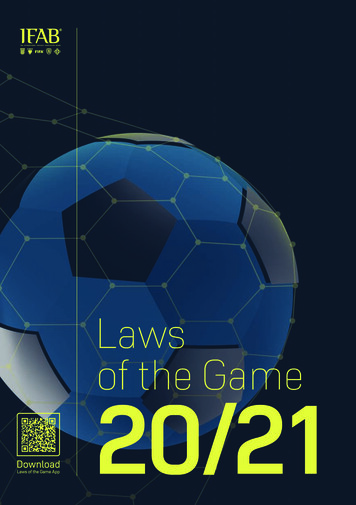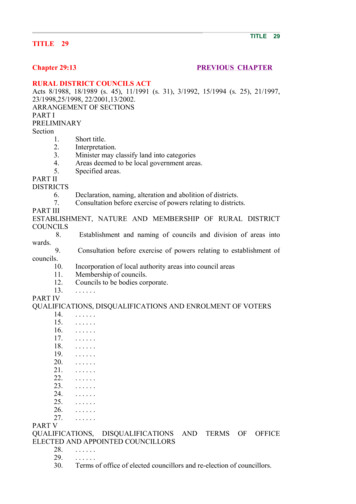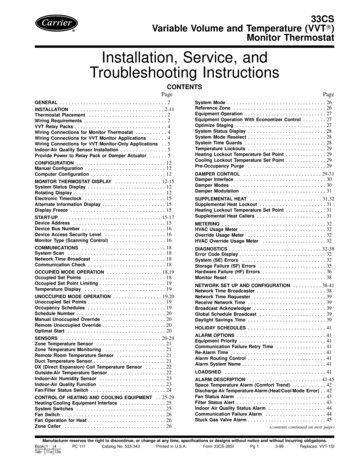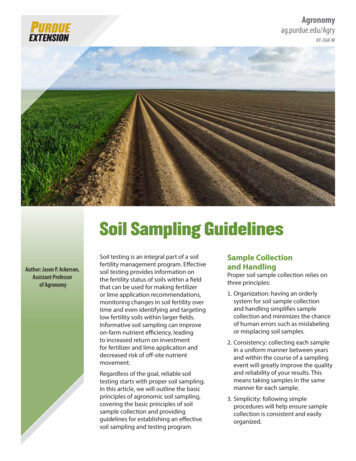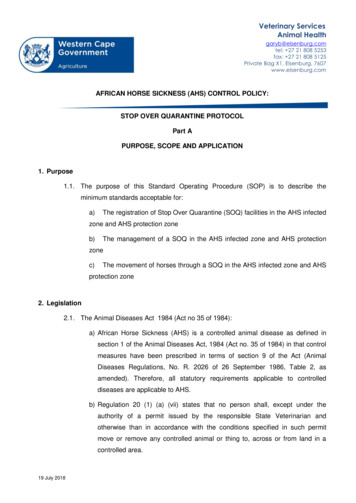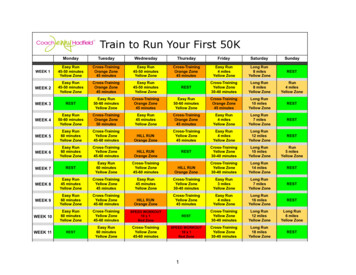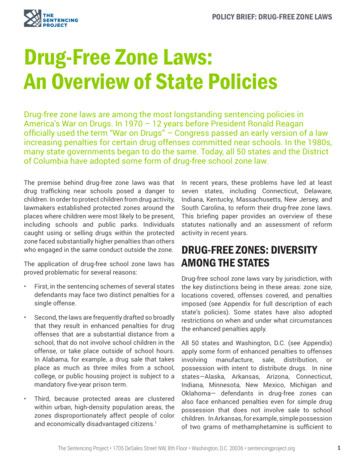
Transcription
POLICY BRIEF: DRUG-FREE ZONE LAWSDrug-Free Zone Laws:An Overview of State PoliciesDrug-free zone laws are among the most longstanding sentencing policies inAmerica’s War on Drugs. In 1970 – 12 years before President Ronald Reaganofficially used the term “War on Drugs” – Congress passed an early version of a lawincreasing penalties for certain drug offenses committed near schools. In the 1980s,many state governments began to do the same. Today, all 50 states and the Districtof Columbia have adopted some form of drug-free school zone law.The premise behind drug-free zone laws was thatdrug trafficking near schools posed a danger tochildren. In order to protect children from drug activity,lawmakers established protected zones around theplaces where children were most likely to be present,including schools and public parks. Individualscaught using or selling drugs within the protectedzone faced substantially higher penalties than otherswho engaged in the same conduct outside the zone.The application of drug-free school zone laws hasproved problematic for several reasons: First, in the sentencing schemes of several statesdefendants may face two distinct penalties for asingle offense. Second, the laws are frequently drafted so broadlythat they result in enhanced penalties for drugoffenses that are a substantial distance from aschool, that do not involve school children in theoffense, or take place outside of school hours.In Alabama, for example, a drug sale that takesplace as much as three miles from a school,college, or public housing project is subject to amandatory five-year prison term. Third, because protected areas are clusteredwithin urban, high-density population areas, thezones disproportionately affect people of colorand economically disadvantaged citizens.1In recent years, these problems have led at leastseven states, including Connecticut, Delaware,Indiana, Kentucky, Massachusetts, New Jersey, andSouth Carolina, to reform their drug-free zone laws.This briefing paper provides an overview of thesestatutes nationally and an assessment of reformactivity in recent years.DRUG-FREE ZONES: DIVERSITYAMONG THE STATESDrug-free school zone laws vary by jurisdiction, withthe key distinctions being in these areas: zone size,locations covered, offenses covered, and penaltiesimposed (see Appendix for full description of eachstate’s policies). Some states have also adoptedrestrictions on when and under what circumstancesthe enhanced penalties apply.All 50 states and Washington, D.C. (see Appendix)apply some form of enhanced penalties to offensesinvolving manufacture, sale, distribution, orpossession with intent to distribute drugs. In ninestates—Alaska, Arkansas, Arizona, Connecticut,Indiana, Minnesota, New Mexico, Michigan andOklahoma— defendants in drug-free zones canalso face enhanced penalties even for simple drugpossession that does not involve sale to schoolchildren. In Arkansas, for example, simple possessionof two grams of methamphetamine is sufficient toThe Sentencing Project 1705 DeSales Street NW, 8th Floor Washington, D.C. 20036 sentencingproject.org1
POLICY BRIEF: DRUG-FREE ZONE LAWSTable 1. Drug-Free Zone Sizes by State 1,000 sMinnesotaRhode IslandVermontWyoming1,000 evadaNew HampshireNew JerseyNew MexicoNew YorkNorth CarolinaNorth Dakota 1,000 ft.OhioOklahomaOregonPennsylvaniaSouth CarolinaSouth on, D.C.West ouriOklahomaSouth CarolinaArizona’s drug-free zones apply 300 feet from school property on private property and 1,000 feet from schoolproperty on public property.atrigger a ten-year sentence with no parole in additionto the sentence imposed for the underlying offense.As seen in Table 1, 32 states and the District ofColumbia establish a zone area that extends 1,000feet in all directions from the property line of schoolsand other protected areas. Thus, in most statesa drug sale that takes place at a distance of morethan three football fields away from a school buildingcan result in enhanced prison time. Ten states havedrawn zones more tightly so as to avoid overreachingin their impact, while seven others have cast a muchwider net of 1,500 feet or more.Though the stated intent of drug-free zone laws wasto protect schools, 31 states have extended the scopeof their policies to areas beyond elementary andsecondary schools and onboard school buses. Forexample, several states have enacted zones aroundpublic housing facilities, public parks, churches, anddaycare centers. Others, including Missouri andWest Virginia, include colleges and universities intheir definition of “school.” Utah adds shopping malls,amusement parks, and the parking lots of such areasto the list of covered areas.31 states have extended the scopeof their policies to areas beyondelementary and secondary schools.The most expansive law in terms of covered locationsis that of Arkansas, which draws zones aroundschools, public parks, public housing facilities, daycare centers, colleges and universities, recreationcenters, skating rinks, Boys’ and Girls’ Clubs,substance abuse treatment facilities, and churches.PENALTIESDrug-free zone laws apply enhanced penalties in twodifferent ways among the states. In thirty states, thelaw designates drug offenses within the protectedzone as distinct crimes with their own penalties orpenalty ranges. In Colorado, for example, sale ofa controlled substance within a drug-free zone is adistinct criminal offense that carries an eight-yearmandatory minimum sentence. In other states, thelaw prescribes enhanced penalties for underlyingcrimes when they occur within the protected zone. InArizona, for instance, committing a covered offensewithin a drug-free zone increases the presumptiveminimum and maximum penalties for the underlyingoffense by one year.States also vary in the severity of the penaltiesdrug offenders receive for violating drug-free schoolzone laws. In 13 states, violation of the law triggersa mandatory minimum sentence or sentenceenhancement that ranges from one year in Virginiato eight years in Colorado. In Washington, DC, RhodeIsland, and the state of Washington, the drug-freeThe Sentencing Project 1705 DeSales Street NW, 8th Floor Washington, D.C. 20036 sentencingproject.org2
POLICY BRIEF: DRUG-FREE ZONE LAWSzone violation doubles the maximum penalty for theunderlying offense.Kansas, Nebraska, and Tennessee elevate the felonyclass of the underlying drug offense when it iscommitted within a drug-free zone, thereby exposingthe defendant to harsher penalties. Similarly, Delawareand Nevada treat violation of the drug-free zone asan aggravating factor in the sentencing proceedingfor the underlying drug offense. Finally, some statesallow juvenile defendants to be prosecuted for a drugfree zone offense in adult court and to be sentencedto an adult institution for violations of drug-free zonelaws.LIMITATIONS ON DRUG-FREEZONESA number of states have imposed various restrictionson their drug-free zone laws with the intention ofnarrowing their focus to more closely align with theoriginal purpose of the law. Lawmakers have limitedthe application of the zone laws based on the natureof the transaction, the age of the defendant, the timeof day, the presence of children, and whether theoffense takes place on public or private property.Seven states—Alaska, Georgia, Louisiana, Montana,New Jersey, Texas, and Washington—apply anexception to their drug-free zone laws if the offenseoccurs within a private residence so long as nochildren are present and the defendant did notprofit from the offense. Virginia similarly applies itslaw only on public property. California, Nebraska,and West Virginia exempt juvenile defendantsfrom enhanced penalties, as does New Mexico forpossession offenses. Florida, Massachusetts, andNevada impose some form of time restrictions ontheir laws so that they only apply when children arepresent.New York and South Carolina require that defendantsknow they are in the zone when they commit theoffense, while North Carolina and North Dakotaexempt small quantities of marijuana from their zonelaws. Indiana is unique in that it creates affirmativedefenses to its zone law: defendants may avoid theenhanced penalties of the law if they were only brieflyin the zone while no minors were present or if theywere in the zone solely because law enforcementofficers stopped them thereDRUG-FREE ZONE LAWS:REFORMSWhile courts have been reluctant to grantConstitutional challenges to drug-free zone laws,concerns over the laws have led a number of statelegislatures to reform their drug-free zone policies.By 2005, lawmakers in Massachusetts, New Jersey,and Connecticut had commissioned studies tosurvey the impact and effectiveness of drug-freezone laws in their respective states, and identifiedproblems regarding the scope of their respectivezones and resulting racial disparities.2 Severalstates have since enacted policy reforms includingMassachusetts, New Jersey, Connecticut, andIndiana. Delaware, Kentucky and South Carolina alsoreformed their drug-free zone laws as part of largerdrug law reform bills. But other states, includingArkansas, Hawaii, and Texas, have adopted harsherpenalties by expanding locations to include publichousing and playgrounds where selling drugs cantrigger enhanced penalties.3CONNECTICUTConnecticut’s harsh drug-free zone law was enactedin 1987. In 2001, Connecticut legislators changedstate law to grant judges discretion in applying theschool zone penalty in certain drug offenses basedon “good cause.”4 Yet the Connecticut statuteimposing a three-year mandatory minimum sentencefor committing a drug offense within 1,500 feet of aschool, public housing complex, or daycare centerremains in effect.However, further reforms may soon be enacted. Inthe 2013 legislative session, Connecticut’s Blackand Puerto Rican Caucus sponsored a bill that wouldhave reduced the size of the state’s drug-free zonesfrom 1,500 feet to 300 feet. The bill was debatedin the Connecticut House of Representatives butRepublican opponents succeeded in filibustering thebill and its time expired without a vote. As a result,the bill stalled and will not become law for 2013.The Sentencing Project 1705 DeSales Street NW, 8th Floor Washington, D.C. 20036 sentencingproject.org3
POLICY BRIEF: DRUG-FREE ZONE LAWSNevertheless proponents of the bill have vowed tointroduce it again in the next legislative session.DELAWAREDelaware’s drug-free zone law was first adopted in1989 and created 1,000-foot zones around schoolsand 300-foot zones around parks. Commission of adrug offense—including simple possession—withinthe zone constituted a distinct felony offense. In2011, as part of a general effort to reduce excessivepenalties for drug users and lower level sellers, theGeneral Assembly passed and Governor Jack Markellsigned a bill that substantially reformed the state’sdrug laws.The 2011 law shrunk Delaware’s drug-free zonesfrom 1,000 feet to 300 feet. It also created threecategories of drug offenses—simple possession,aggravated possession, and drug dealing—with thesentence for each offense depending on the typeand quantity of drug involved and the presenceor absence of aggravating circumstances. Thelaw makes commission of the underlying offensewithin a drug-free zone an aggravating factor for thepurposes of sentencing.INDIANAIndiana’s original drug-free zone law, passed in 1987,raised the felony class of the underlying drug offensefrom Class B to Class A if the offense occurred within1,000 feet of school property, a public park, a publichousing complex, or a youth program center. Understate law, the penalties imposed for committing aClass A felony are substantially harsher than thoseimposed for a Class B felony: a Class A felonyexposes a defendant to a sentence of 20 to 50 yearsin prison with an advisory sentence of 30 years, whilea Class B felony exposes a defendant to a sentenceof 6 to 20 years in prison with an advisory sentenceof 10 years. In 2007, two bills were introduced—onein each house of the legislature—that would haveexpanded drug-free zones to churches and markedbus stops, respectively.In response to the 2007 bills, Kelsey Kauffman,formerly of DePauw University, and her studentsbegan studying the impact and effectiveness ofthe state law. Their findings were similar to thosein Massachusetts and Connecticut: drug-freezones blanketed large portions of inner city areasin Indianapolis and more than 75% of defendantswho had their felony class raised under the drugfree zone statute were black.5 Professor Kauffmanand her students presented their findings before theIndiana Senate Committee on Corrections, Criminal,and Civil Matters in 2007 and 2008 and again beforethe specially-convened Indiana Sentencing PolicyStudy Committee in October 2008. Their testimonycontributed to the defeat of the bills in the legislature.In a drug-free zone case in February 2012, the IndianaSupreme Court reduced the 20-year sentence of aKokomo man convicted of possessing small amountsof marijuana and cocaine within a drug-free zone.6Because the man would have faced a maximumprison sentence of only 18 months if his offensehad occurred outside the zone, the court found thatthe 20-year sentence was grossly disproportionateto the severity of the crime. Furthermore, the courtsignaled that it would continue to reduce harshsentences imposed under the drug-free zone lawwhen it reduced a similar sentence in June 2012.7In response, to address the concerns of the IndianaSupreme Court as well as the issues documented in theDePauw University study, the legislature passed andGovernor Mike Pence signed a bill that substantiallyreformed the state’s law. The bill reduced Indiana’szones from 1,000 feet to 500 feet and eliminated thezones around public housing complexes and youthprogram centers. It also added the requirement thata minor must be reasonably expected to be presentwhen the underlying drug offense occurs. Lastly, themeasure made violation of the drug-free zone lawan “enhancing circumstance” of the underlying drugoffense, the severity of which is dependent upon thetype and quantity of the drug involved. Because thelaw also restructures Indiana’s felony classificationstructure and penalties, a defendant sentenced underthe revised law now faces a mandatory minimumpenalty of one year rather than twenty years.The Sentencing Project 1705 DeSales Street NW, 8th Floor Washington, D.C. 20036 sentencingproject.org4
POLICY BRIEF: DRUG-FREE ZONE LAWSKENTUCKYLawmakers modified the state’s drug free zonein 2011. The provision was included in a largerpackage of sentencing reforms that were adoptedto address the state’s growing prison population.State lawmakers shrunk the drug free zone from1,000 yards to 1,000 feet. Anecdotal reports suggestthat the original zone was a mistake given that moststates impose a zone measured in feet rather thanyards. The change in policy was adopted withoutoppositionMASSACHUSETTSIn 1989, the General Assembly of Massachusettspassed the state’s first drug-free zone law, whichimposed a 2-15-year mandatory minimum sentencefor convictions of selling or distributing drugs within1,000 feet of a school. A 1993 amendment drew a100-foot zone around parks, and a 1998 amendmentadded a 1,000-foot zone around day care and HeadStart facilities.8 Efforts to reform the law beganin 2000, when Dorchester District Court JudgeSydney Hanlon noticed that a majority of drug-freezone defendants in her courtroom were black orHispanic and requested that Northeastern Universityresearchers conduct an analysis on the racial impactof the law. The researchers documented that 80% ofthe defendants who received enhanced sentencesunder the drug-free zone law were black or Hispanic—even though 45% of those arrested for drug violationsstatewide were white.The next layer of drug-free zone research wasconducted by William Brownsberger at the BostonUniversity School of Public Health. In his analysisof 443 drug sale cases in Fall River, New Bedford,and Springfield, Massachusetts, Brownsbergerfound that school zones covered 29% of the threestudied cities and 56% of high-poverty areas.9 Thesefindings led Brownsberger to recommend that theMassachusetts zone be shrunk from 1,000 feet to100-250 feet.These findings were bolstered by a 2009 reportissued by the Prison Policy Initiative (PPI). PPI’sresearch, which focused on Hampden County inwestern Massachusetts, revealed that residents ofurban areas were five times as likely to live withina drug-free zone as residents of rural areas.10 Thedata further showed that more than half of blackand Hispanic residents lived in drug-free zones whileless than a third of white residents did so. PPI alsofound that the addition of Head Start facilities tothe law in 1998 disproportionately impacted poorneighborhoods since such facilities service poorneighborhoods and are therefore more likely to belocated there.As a result of the issues surrounding the state’sdrug-free school zone law, legislators serving onMassachusetts’s joint Judiciary Committee approveda bill that would have shrunk the size of the zones andlimited the hours of their effectiveness, but it died onthe floor of the General Assembly. In the summer of2012, however, with the endorsement of GovernorDeval Patrick, the General Assembly passed a billthat reduced the size of Massachusetts’s zones from1,000 feet to 300 feet and limited the hours of thezones’ operation from 5 a.m.- midnight.NEW JERSEYNew Jersey first enacted its drug-free zone law as partof sweeping drug legislation in 1987. The original lawdrew a 1,000-foot zone around schools; distributing,dispensing, or possessing with intent to distributedrugs within that zone was classified as a third-degreefelony with a three-year mandatory minimum prisonsentence. In 1998, New Jersey lawmakers added a500-foot zone for drug sales around public housingcomplexes, parks, libraries, and museums. Violationof the 1998 law constituted a second-degree offense,for which a prison term is the presumptive sentence.Furthermore, New Jersey courts have interpreted theword “school” in the statute to be broad, includingdaycare centers, vocational training centers, andother educational facilities.Advocacy organizations including the Drug PolicyAlliance and Families Against Mandatory Minimumsprioritized reform of the state’s drug-free schoolzone laws. This was instrumental in the legislature’sdecision to convene the New Jersey Commissionto Review Criminal Sentencing in 2004. TheCommission found that that enforcement of the drug-The Sentencing Project 1705 DeSales Street NW, 8th Floor Washington, D.C. 20036 sentencingproject.org5
POLICY BRIEF: DRUG-FREE ZONE LAWSfree-zone laws had a devastating impact on minoritydefendants because New Jersey’s densely populatedurban areas were transformed into massive “drugfree” zones. Nearly every defendant (96%) convictedand incarcerated for a drug-free zone offense in NewJersey was either black or Latino.11 The Commissionrecommended that the legislature shrink the sizeof the zones from 1,000 to 200 feet and eliminatethe mandatory minimum sentence for school zoneviolations.The commission’s bill passed in committee in 2005but stalled in the legislature later that year. Five yearslater, Governor Jon Corzine signed into law a bill thatdid not alter the 1,000-foot zone size, but eliminatedthe mandatory minimum prison sentence for schoolzone offenses and enhanced judicial discretion insuch cases.SOUTH CAROLINASouth Carolina maintains an expansive zone of morethan 2,600 feet, or a half mile, around restrictedareas. However, lawmakers modified the triggers forpenalty enhancements in restricted areas when acomprehensive package of sentencing reforms thatgarnered bipartisan support was adopted in 2010.The modification requires that anyone arrested fora drug offense in an enhancement zone must haveknowledge that he or she was in a restricted areawith the intent of selling.CONCLUSIONDrug-free zone laws were initially promoted as anattempt to keep dangerous drug activity away fromchildren. In practice, drug-free zone laws havecreated a number of serious issues within the criminaljustice system, by frequently imposing excessivepenalties and by subjecting urban poor and minoritypopulations to harsher penalties than others forsimilar drug offenses. Spurred by more than a decadeof research, a number of states are taking measuresto reform their drug-free zone laws to alleviate theburdens they impose on poor people and people ofcolor with no benefit to public safety. These statesshould serve as a model for other jurisdictions asthe movement for fairer, more effective drug lawscontinues to build momentum in the United States.ENDNOTES1 Greene, J., Pranis, K., and Ziedenberg, J. (2006). Disparity by Design: How drug-free zone laws impact racial disparity– and fail to protect youth. Justice Policy Institute. Available at /documents/06-03 rep disparitybydesign dp-jj-rd.pdf.2 Ibid.3 Lawrence, A. (2013). “Trends in Sentencing and Corrections: State Corrections.” National Conference of StateLegislatures. Available at gAndCorrections.pdf.4 Legislative Program Review & Investigations Committee. (2005). “Mandatory Minimums Report.” Available at ory Minimum Sentences Final Report.htm.5 Kauffman, K., et al. (2008). Testimony before the Sentencing Policy Study Committee. Available at http://dpuadweb.depauw.edu/ 1 kkauffman/newdrugzonelaws/Testimony.html.6 Abbot v. State, 961 N.E.2d 1016 (Ind. 2012).7 Walker v. State, 968 N.E.2d 1292 (Ind. 2012) (per curiam).8 Prison Policy Initiative. (2009). The Geography of Punishment: How Huge Sentencing Enhancement Zones HarmCommunities & Fail to Protect Small Children. Available at http://www.prisonpolicy.org/zones/.9 Brownsberger, W. (2001). An Empirical Study of the School Zone Law in Three Cities in Massachusetts.10 Prison Policy Initiative. (2009). The Geography of Punishment: How Huge Sentencing Enhancement Zones HarmCommunities & Fail to Protect Small Children. Available at http://www.prisonpolicy.org/zones/.11 Staff. (2007). “Supplemental Report on New Jersey’s Drug Free Zone Crimes & Proposal for Reform.” The New JerseyCommission to Review Criminal Sentencing. Available at schoolzonereport.pdf.The Sentencing Project 1705 DeSales Street NW, 8th Floor Washington, D.C. 20036 sentencingproject.org6
POLICY BRIEF: DRUG-FREE ZONE LAWSAppendix. Drug-Free School Zone Laws by StateStateStatuteZone SizeCovered LocationsCovered OffensesPenaltiesLimitationsAlabamaCode of Ala.§ 13A-12-25015,460 ft.Schools (includescolleges), publichousing projectsSale5-year mand min,no paroleN/AAlaskaAK Stat. §11.71.040-41500 ft.Schools, schoolbuses, youth andrecreation centersPossession w/recklessness(either 3rd or 4thdegree felony)Class C or ClassB felonyPrivateresidence personalArizonaA.R.S. § 133411300 ft. (private Schoolsproperty);1,000 ft.(publicproperty)Sale, possession,manufactureIncreasespresumptive minand max by 1yearN/AArkansasA.C.A. § 5-64- 1,000 ft.411Public parks, schools(includes collegesand universities),school bus stops,skating rinks,YMCAs, communitycenters, publichousing complexes,substance abusetreatment facilities,day care centers,churchesPossession,delivery,manufacture, sale10-year additional N/Asentence(concurrent orconsecutive),no paroleCaliforniaAnn.Cal.Health &Safety Code§ 11353.61,000 ft.SchoolsPossession w/intent, delivery,sale, manufacture3-5 yearsdiscretionaryDefendant 18 years old;school hoursonly; onlyapplies toplaces childrenexpected to beColoradoC.R.S.A § 181.3-4071,000 ft.Schools, schoolbusesPossession w/intent, delivery,sale, manufacture8-year mandatoryminN/AConnecticutC.G.S.A. §21a-278a1,500 ft.Schools, publichousing complexes,day care centersPossession w/intent, delivery,sale, manufacture3-year mandmin additional(consec)N/ADelaware16 Del.C. §4701300 ft.Schools, parks,churches, rec. areasPossession w/intent, delivery,sale, manufactureAggravatingFactor (Min.Class D FelonyN/ADistrict ofColumbiaDC ST § 48904.07a1,000 ft.Schools (includingDistribution,universities), daypossession w/care centers, publicintent to distributeswimming pools,playgrounds, arcades,youth centers, publichousing complexesUp to 2x fineUp to 2xmaximumsentenceN/AFloridaF.S.A. §893.131,000 ft.Schools (includingPossession w/universities), day care intent, delivery,centers, churches,sale, manufacturepublic housingcomplexes, parks3-year man minEffective only6am-midnight(schools only)GeorgiaGa. CodeAnn. § 16-1332.41,000 ft.Schools, parks,playgrounds,recreation centers,public housingcomplexesPossession w/intent, delivery,sale, manufactureUp to 20 years Private 20,000residence fine (consecutive) personal no child 17presentHawaiiHRS § 7121249.6750 ft.Schools, schoolbuses, parks, publichousing complexesPossession w/intent, delivery,saleClass C or ClassD felonyThe Sentencing Project 1705 DeSales Street NW, 8th Floor Washington, D.C. 20036 sentencingproject.orgN/A7
POLICY BRIEF: DRUG-FREE ZONE LAWSStateStatuteZone SizeCovered LocationsCovered OffensesPenaltiesLimitationsIdahoI.C. § 372739B1,000 ft.SchoolsPossession w/intent, delivery,sale, manufacture5-year mand minto lifeN/AIllinois720 ILCS570/4071,000 ft.Schools, schoolPossession w/buses, public housing intent, delivery,complexes, publicsale, manufactureparks, churches,nursing homesClass X FelonyN/AIndianaIC 35-48-4-16500 ft.Schools, parksPossession,deliveryLevel 4 FelonyDefenses:1) Briefly inzone whileminor waspresent;2) No minorpresent;3) Law officerrequested orstopped in zoneIowaI.C.A. §124.401A1,000 ft.SchoolsPossession w/intent, delivery,sale, manufactureUp to 5 yearenhancementDefendant 18years oldKansasK.S.A. 2157051,000 ft.SchoolsPossession w/intent, sale 1 Felony LevelN/AKentuckyKRS §218A.14111,000 ft.SchoolsTraffickingClass D FelonyN/ALouisianaLSA-R.S.40:981.32,000 ft.Schools (includinguniversities), drugtreatment facilities,religious facililties,public housingcomplexes, day carecentersPossession w/intent, saleMaximum fine up to 1.5times maximumsentencePrivateresidence no child 18presentMaine17-A M.R.S.A§ 1105-A1,000 ft.Schools, schoolbusesTraffickingVaries based ondrugN/AMarylandM.D. Code,Criminal Law,§ 5-6271,000 ft.Schools, schoolbusesPossession w/intent, delivery,sale, manufactureUp to 20 years(1st offense);5-year mand min(2nd )N/AMassachusetts M.G.L.A. 94C§ 32J300 ft.Schools, preschools;parks (100 ft.)Possession w/intent, delivery,sale, manufacture2-15 years5am-midnightonlyMichiganM.C.L.A.333.74101,000 ft.Schools, librariesPossession w/intent, delivery,sale, manufacture2-year minimum(judgemay modify)N/AMinnesotaM.S.A. §152.01300 ft.Schools, parks, public Possession,housing complexesdelivery,manufacture, saleSentence degreeenhancementN/AMississippiMiss. CodeAnn. §41-291421,500 ft. frombuilding;1,000 ft. fromproperty lineSchools, churches,public parks,ballparks, publicgyms, youth centers,movie theatersPossession w/intent, delivery,sale, manufacture3 year mand minto lifeN/AMissouriV.A.M.S.195.2142,000 ft.Schools (includinguniversities), schoolbusesDistribution, saleClass A FelonyN/AMontanaMCA 45-91091,000 ft.SchoolsDistribution, sale3 year mand minto lifePrivateresidence no child 18presentThe Sentencing Project 1705 DeSales Street NW, 8th Floor Washington, D.C. 20036 sentencingproject.org8
POLICY BRIEF: DRUG-FREE ZONE LAWSStateStatuteZone SizeNebraskaNeb.Rev.St. § 1,000 ft.28.416NevadaN.R.S.453.3345NewHampshireCovered LocationsCovered OffensesPenaltiesLimitationsSchools, playgrounds, Possession w/colleges (1,000 ft.);intent, delivery,youth centers, videosale, manufacturearcades, public pools(100 ft.) 1 Felony LevelDefendant 18years old1,000 ft.Schools, campuses,school bus stopsplaygrounds, parks,pools, video centers,arcadesManufacture,delivery, saleAggravatingFactorWithin 1 hourof school hours(school busstop only)N.H. Rev.Stat. §193B:11,000 ft.Schools, schoolbusesPossession w/intent, delivery,sale, manufacture1 year mand min 2x maximumpenalty forunderlyingoffenseN/ANew JerseyN.J.S.A.2C:35-71,000 ft.Schools, schoolbusesPossession w/intent, delivery,sale3 year mand min,no paroleJudge mayadjust paroleineligibilitybased onmitigatingfactors; privateresidence no child 18present notfor profitNew MexicoN. M. S. A.1978, § 3031-2(Y)1,000 ft.SchoolsPossession,delivery,manufacture, saleFirst-class Felony Possessionlimited todefendants 18years oldNew YorkMcKinney’sPenal Law §220.441,000 ft.Schools, day carecentersTraffickingClass B FelonyLimited to areas“accessible”to public; somedrugs requireknowledge ofzoneNorth CarolinaN.C.G.S.A. §90-951,000 ft.Schools, child carecenters, parksPossession w/intent, delivery,sale, manufactureClass E Felony 5 g marijuanaexceptedNorth DakotaNDCC, 1903.1-23(3)(a)1,000 ft.SchoolsPossession w/intent, delivery,sale, manufacture8-year sentence;If defendant 21,8-year mand minMarijuanaexceptedOhioR.C. §2925.01(P)1,000 ft.SchoolsSaleMin. 4th DegreeFelonyN/AOklahoma63 Okl.St.Ann. §2-401(F)2,000 ft.Schools (includinguniversities), parks,public housingcomplexes, child carecentersPossession w/intent, delivery,sale2x max sentenceN/AOregonO.R.S. §475.9041,000 ft.SchoolsDelivery,manufactureClass A FelonyN/APennsylvania18 Pa.C.S.A.§ 63171,000 ft.Schools, parks,playgrounds; schoolbuses (250 ft)Possession w/intent, delivery,sale2-year mand minN/ARhode IslandGen.Laws1956, § 2128-4.07.1900 ft.Schools, parks,playgroundsDistribution,manufacture2x max sentence2x max fineN/AThe Sentencing Project 1705 DeSales Street NW, 8t
1,000 feet of school property, a public park, a public housing complex, or a youth program center. Under state law, the penalties imposed for committing a Class A felony are substantially harsher than those imposed for a Class B felony: a Class A felony exposes a defendant to a sentence of 20 to 50 years



